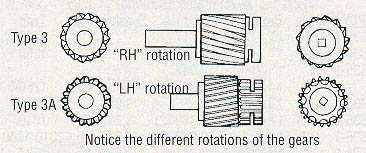|
Home
Factory Gage Installation
The 429 CJ Cougar Option
Ford Duraspark Distributor
Inspection Decals
Speedo Gears
429 Engine Detail
Identifying Platings
Rear Sway Bar
Valve Lash Mustang Central
| |
Making Your
Speedometer Gear Accurate
By Dan Davis
First off, the way to get the whole system to
work right is to make the speed cable rotate 1,000 revolutions for every mile
the car is driven. This is done by adjusting the transmission driven to drive
gear ratio on the speed cable to match the tire size and rear axle gear ratio of
the car.
The first thing to know is how many revolutions the tires make in one mile. To
calculate this, measure the diameter of your tires. 26" is about average for
F60-15's or 245-60-15's. Multiply this measurement (26") by pi (3.1416). This
will give you the circumference of the tire. Next, divide one mile in inches
(63360) by the circumference of tire (63360 divided by (26 x pi)=776). This
equals the revs per mile of the tire. Now multiply this number by the rear axle
ratio to give you the number of drive shaft revs per mile (776 x 3.91= 3033).
Next, divide this number by 1000 (3033 divided by 1000 = 3.033). This is the
ratio of transmission driven/drive gears on speedometer cable you will need in
this case use a driven gear with 18 teeth and a drive gear with 6 teeth (18
divided by 6 = 3.0). This is the best choice which yields a 1.1% high error
which means your odometer unit indicates 1.1% greater than actual or 10.11 for
an actual 10.0 miles. If you are using the Ford adapter/reducer (reducer was
factory equipped on cars with 3.91, 4.11 or 4.30 rear axle ratios), multiply the
number by 0.75 (3.033 x 0.75=2.274). This is the driven/drive ratio you need. A
3.75% error (i.e., a 0.375 mile error in 10 miles) is considered acceptable by
design.
When picking a driven/drive gear ratio to match the tire and rear axle gear
ratio you have a choice of drive gears and driven gears.
The drive gear is inside the transmission and the tail housing must be removed
to get at it. You may be able to see what gear your transmission has by looking
in the hole where the speedometer cable goes with a light. Manual transmissions
have a plastic gear pressed onto the output shaft. The manual trans drive gear
is also color coded: pink (6 teeth) or black (7 teeth). Toploaders use the "type
4a" drive gear while automatics use a gear machined to the output shaft with
either 8 or 9 teeth. Automatics have a metal gear machined into the output
shaft. To change the latter, the whole output shaft must be changed, a big job.
The driven gear clips onto the end of the speed cable. These plastic gears are
unique between the manual Toploader transmission and the gears in an automatic
transmission. The uniqueness is due to the helix direction of the gear teeth.
This is the curvature as seen when looking at the gear teeth. The automatic
transmissions are right hand helix (known as type 3). The speedometer cable
enters the transmission on the driver's side of the car. The Toploader
transmissions with the shift linkage outside of the transmission are left hand
helix (known as type 3a). The speedometer cable enters the transmission on the
passenger side.
All driven gears are color coded whether they're used with an automatic or
manual transmission The automatic and today's manuals are molded in color. The
Toploader driven gears are molded in off-white colored plastic and the tips are
color coded with paint.
Your choices are (tooth count and color code): 16 (blue for AT, orange for MT),
17 (green AT, purple MT), 18 (grey AT, green MT), 19 (tan AT, pink MT), 20
(orange AT, blue MT), 21 (purple AT, red MT) and 23. The 23 tooth gear is from
Saleen (
http://www.saleen.com/store2000/detail_new.asp?car=saleen&prodid=047-280 )
and costs $22, but the teeth are thin and the gear will wear out every couple of
years. If you cannot make it work with this stuff, you have one more option --
get a reducer box like Ford used with Drag Pak cars. The original is spendy
(~$350), but a generic box can be had from a speedo calibration shop for a lot
less. I would chose this method over changing the output shaft on an AT unless I
had to remove the trans anyway
Here is a handy chart to chose your gear combo after you have done the math
shown in the first paragraph. The ranges shown comply with the Ford approved +/-
3.75% allowable error:
Toploader choices:
16/6 = 2.567-2.767
17/6 = 2.728-2.940
18/6 = 2.888-3.113
19/6 = 3.048-3.286
20/6 = 3.209-3.459
21/6 = 3.369-3.631
23*/6 = 3.690-3.978
16/7 = 2.200-2.372
17/7 = 2.338-2.520
18/7 = 2.475-2.667
19/7 = 2.610-2.814
20/7 = 2.750-2.964
21/7 = 2.888-3.113
23*/7 = 3.163-3.409
C4 & C6 choices:
16/7 = 2.200-2.372
17/7 = 2.338-2.520
18/7 = 2.475-2.667
19/7 = 2.610-2.814
20/7 = 2.750-2.964
21/7 = 2.888-3.113
23*/7 = 3.163-3.409
16/8 = 1.925-2.075
17/8 = 2.045-2.205
18/8 = 2.166-2.334
19/8 = 2.286-2.464
20/8 = 2.406-2.594
21/8 = 2.527-2.723
23*/8 = 2.767-2.983
16/9 = 1.711-1.845
17/9 = 1.818-1.960
18/9 = 1.925-2.075
19/9 = 2.032-2.190
20/9 = 2.139-2.305
21/9 = 2.246-2.420
23*/9 = 2.460-2.652
* = Saleen part, not Ford part

Hope this helps!
--
Regards,
Dan Davis
**************************************************************************
Another Speedo Gear resource that may be of help is located
on the 428 Cobra Jet Mustang Registry website;
Mustang 428 Cobra Jet Speedometer Gear Calculator
|
![]()
![]()